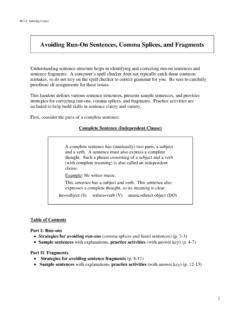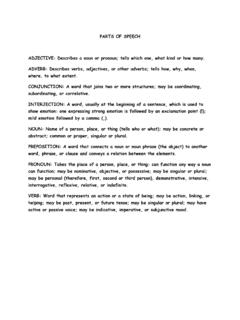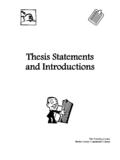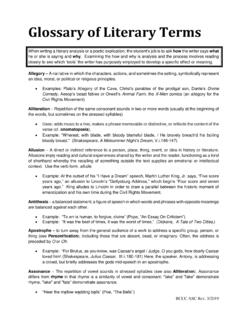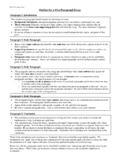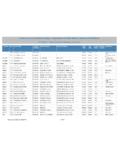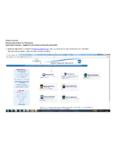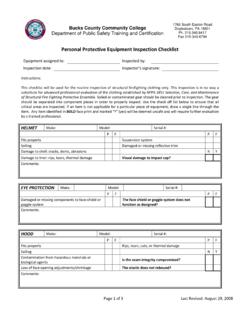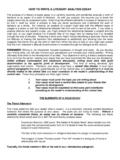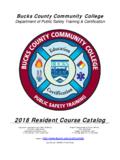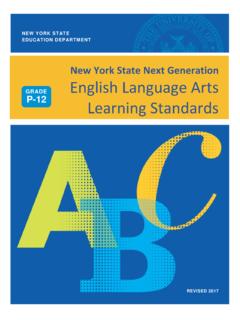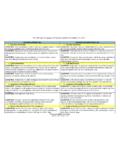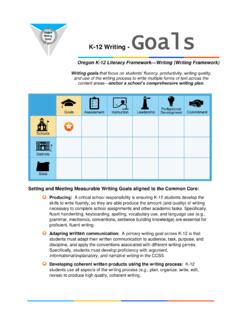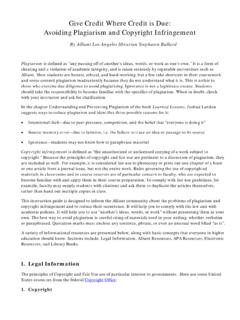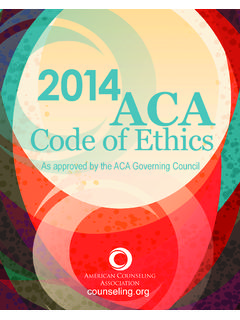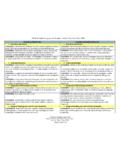Transcription of Understanding the Research Process
1 Understanding the Research Process The argumentative Research paper is both challenging and confrontational. It requires the academic writer to form an opinion and to take a position on the subject matter presented. All facts are presented for the purpose of supporting the central argument (your thesis statement). As you conduct your Research , always ask yourself: "How does this help me make my point?" If the evidence will not work toward your thesis statement, you will need to scrap these sources, facts, and evidence and modify your Research Process .
2 The bottom line: Your Research needs to support your argument, not make it for you. To get started, it helps to break the Research paper Process into four distinct parts: laying the groundwork, developing a strategy, organizing and beginning to write, and finalizing. Part 1. Laying the Groundwork for your Research Paper Choosing a Research Paper Topic Your first step in the argumentative Research Process is to choose a topic. A good topic raises questions that have neither absolute nor simple answers. Your topic can range from the traditional to the non-traditional.
3 The key is to find a topic that you are passionate about and that you wish to Research , to argue, and to develop in a paper. Make sure to get professor approval before you get started. Once you have a topic, find an opinion or argument that is of interest to you. How do you view this topic? What do you want to say about this topic? All topics are good topics, but avoid basing your argumentative thesis statement solely on opinion. Place this topic into the larger cultural conversation perspective and focus on creating a thesis statement to defend in your paper.
4 Completing the Preliminary Research Begin with the library to help you get started with your basic introductory reading about your subject and gather background information. This allows you to become more familiar with prospective topics and begin to build your list of tentative sources. As you look through these sources, skim them. Weed out sources of little relevance. If a source is interesting to you, save it for your working bibliography. Join the academic conversation: look for a list or bibliography of further reading at the end of the encyclopedia entries or textbook chapters.
5 What have persons of note (scholars, politicians, researchers, critics, journalists, lawmakers, scientists, etc) said about your subject? Do any of their opinions support ("yes"), contradict ("no"), or support AND contradict ("okay, but") your thoughts on the topic? Beware of issues that are too recent to find adequate Research . You may have to get creative! BCCC Tutoring Center Rev. 7/2016 Forming a Hypothesis, or "Working Thesis Statement" As you collect your sources and brainstorm your topic, your next step is to form a "working thesis statement" early on in your drafting Process .
6 If you create a "working thesis statement," you allow yourself to remain focused in your Research and raise more questions regarding your topic (to help with your discussion points). As you continue to draft and gather information, you will change the keywords in your thesis statement. However, always be sure to have an argumentative goal in mind. The key is to remain flexible to adapt your paper in light of new information. A thesis statement has two parts: the subject and the treatment. The subject is your topic. The treatment is your direction and focus (what you plan to argue, discuss, develop, or examine about your topic).
7 Part 2. Developing a Research Strategy for your Research Paper Find Useful Sources As you put together your tentative source list, consider what sources they are and how they fit into your overall argument (it's okay if you do not have a thesis statement at this point; you just need an idea and a possible direction based on your brainstorming). There are two types of sources: secondary sources and primary sources. A primary source is an original source that has not been changed in any way. Usually, a primary source is a creative work, such as a novel, poem, or play or an original document, such as a diary, historical document, or interview.
8 Some arguments are based upon a primary source; for instance, if a Research paper s topic is Frankenstein, then the Mary Shelley novel of the same name would be a primary source. Another type of source is a secondary source. A secondary source is a credible, academic source which analyzes one or more primary sources. You may use a secondary source to support and develop your overall argument. Examples of secondary sources may include textbooks, critical anthologies, journal articles, newspaper articles, etc. As you search for sources, it is important to distinguish between the types of sources: 1.
9 A print source is a physical print source such as a book, textbook, or magazine/newspaper article. 2. An electronic web source is a credible website. Avoid using blogs, social media posts, online journals, and most .com websites. Wikipedia cannot be used as a source, but consulting the footnotes and links listed in the bibliographical information may be used if deemed academic, relevant, and credible to your argument. Additionally, you can try periodical websites for an online archive ( or ). A Google search is also helpful, but beware!
10 Sometimes you may get more sources than you bargain for, so it is best to use Google Scholar to narrow down your search terms. 3. An academic database source can be found through the BCCC library database (for example, JSTOR). The reference librarians will not only be able to direct you toward any source, but also help you determine which database will work best for you. It is important to make sure your sources are peer-reviewed and are from a credible academic journal. BCCC Tutoring Center Rev. 7/2016 Take Stock of your Sources It is important to organize your sources.
